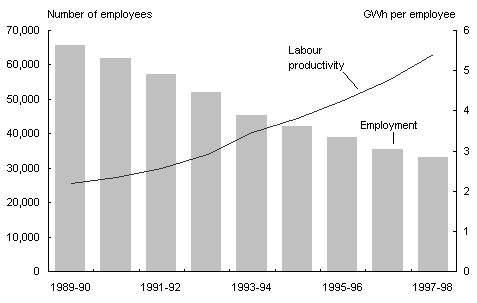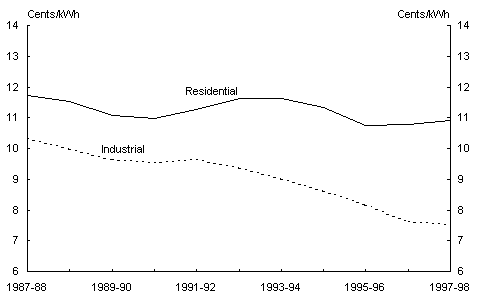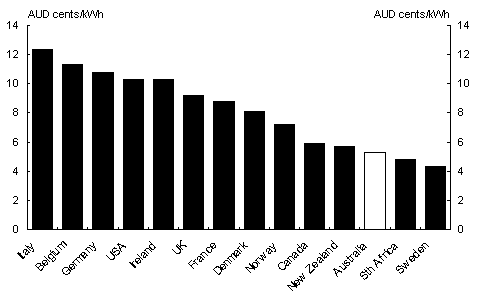Since the late 1980s, the number of persons employed in the electricity industry has almost halved (Chart 4). These staff reductions have been partially offset by the contracting out of non-core services.
The electricity industry has made substantial improvements in productivity, with gigawatt hours produced per employee more than doubling since the late 1980s. While most of the gains are attributable to reduced staff numbers, productivity improvements are also related to other factors.
Chart 4: Electricity industry employment and labour productivity

Source: ESAA, Electricity Australia (various issues).
Investment
Industry commentators have argued that there was significant over-investment or gold-plating in the electricity industry in the mid-1980s, which led to substantial excess capacity. As noted above, this was a key criticism in the Industry Commissions 1991 report on the electricity industry. The existence of excess capacity led to a decline in investment in NSW and Victoria following the commencement of interstate trade in electricity in 1997.
A number of longer term investment opportunities have been identified in the enhanced commercial environment created by the NEM. For example, two interconnectors are currently under construction, with at least one other proposed, and a number of new generators are also under construction or in the planning stages.
Prices
Prior to the introduction of electricity reforms, the prices charged by electricity businesses were heavily regulated. Following the opening of the generation and retail markets to competition, the industry has had more freedom to set its charges. At the same time, competition has put downward pressure on prices.
Over the decade to 1997-98, electricity prices in Australia fell by around 15 per cent in real terms (Chart 5). These price reductions reflected, to some extent, the efficiency improvements that have occurred in the electricity supply industry over this timeframe.
Chart 5: Australian electricity prices (real terms)

Source: ESAA, Electricity Australia (various issues) and Electricity Prices in Australia 1998-99.
While industrial users have experienced the biggest price reductions, household customers have also benefited from the electricity reforms.
-
For example, from 1993-94 to 1997-98, residential electricity prices fell by over 6 per cent in real terms. This equates to an average real saving of around $45 on a residential consumers annual electricity bill.
More recent price movements have also been significant. Following the commencement of the interim NEM in May 1997, generators in Victoria and NSW were able to compete for the right to dispatch electricity to consumers in both States. This resulted in low wholesale electricity prices, which benefited consumers.
-
A 1998 Australian Chamber of Manufactures survey found that contestable customers in Victoria and NSW had achieved savings averaging 26 per cent on their power bills.
-
A 1998 survey by Deloitte Touche Tohmatsu of 100 large companies within the NEM found that three quarters of the companies surveyed had achieved electricity cost savings of more than 20 percent, with average savings of 30 to 35 per cent.
Wholesale prices in NSW and Victoria averaged $14.57 per MWh in 1997-98 which contrasted with industry estimates of long-run sustainable wholesale prices of between $30 and $40 per MWh. Many industry commentators argue that the low wholesale prices observed are unsustainable. Pool prices are now substantially higher than the 1997-98 levels and there has been a 29 per cent price rise for customers with contestable supply in NSW and Victoria over the twelve months to April 1999.
Over time, excess capacity is expected to diminish as demand catches up to supply capability and prices settle around a long-run cost benchmark. There are also further changes still to occur in the electricity market, such as the completion of the Queensland-NSW interconnections, the phasing out of vesting contracts in parallel with full retail contestability, and the removal of jurisdictional derogations from the National Electricity Code. These further changes will no doubt further influence the wholesale market.
International price comparisons
Electricity prices in Australia compare favourably in international terms, with residential and industrial consumers paying among the lowest electricity prices in the world (Charts 6 and 7). Due to its natural resource endowments, Australia has always ranked favourably in international price comparisons. Reforms to the electricity sector will, however, help to reinforce Australias comparative advantage in electricity supply.
Chart 6: International residential electricity prices (as at January 1999)

Source: ESAA, Electricity Australia 1999.
Chart 7: International industrial electricity price (12 month average to March 1999)

Source: NUS International (1999).
Service levels & other benefits
Despite concerns that service levels would decline as a result of corporatisation and industry restructuring, there is no strong evidence to suggest that this is the case. A survey of companies within the NEM reported that while power disruptions remain a concern, reliability is no worse than it was before competition commenced.
As more customers are able to choose their electricity supplier and wholesale prices stabilise, retailers will increasingly compete on service features in addition to price.
An anticipated trend is that electricity retailers will expand their traditional product line and offer household and business customers complete packages for electricity, gas and water and, possibly, other products like telecommunications, banking and insurance. This could lead to lower retail prices through economies of scale and scope. International experience suggests that it will also lead to improved service delivery and greater product innovation.
Electricity industry developments are also being shaped by environmental concerns and, in particular, by Australias international obligations relating to climate change and greenhouse gas emissions. The electricity industry has placed increased emphasis on improving energy efficiency and on using more environmentally friendly fuel sources. Some retailers are now also offering customers the choice of purchasing their electricity from renewable generation sources such as wind, solar, biomass, wave and hydro power.
CONCLUSION
The reforms to the electricity supply industry over the last decade have been a fundamental part of Australias microeconomic reform progr
am. These reforms are leading to more efficient pricing and investment decisions, with ensuing benefits to end users.
The path of reform to date has seen the structure of the electricity industry evolve into a more competitive framework. On the whole, the industry has responded well to these changes and continued to record strong growth. However, it is yet to complete the transition to the new competitive environment.
The industry is still moving towards full contestability for all consumers, and transitional arrangements such as vesting contracts and jurisdictional derogations from the National Electricity Code are yet to be phased out. There are clearly further challenges ahead for businesses, regulators and policy makers alike to maintain the momentum of the reform process and to ensure continued benefits are realised for businesses, consumers and the economy more generally.
9 Transmission losses are the losses in electrical energy that occur as electricity is transported along transmission lines. Ancillary services relate to the management of power system supply (eg provision of generation capability to meet sudden changes in demand for electricity).
10 Treasury estimates based on ESAA, Electricity Australia (various issues), Gotham Press, Sydney.
11 ACM (1998), Outcomes of the Contestable Electricity Market in NSW and Victoria.
12 Deloitte Touche Tohmatsu (1998), Deloitte Electricity Survey.
13 ESAA (1999), Electricity Supply Magazine, February.
14 NUS International (1999).
15 Vesting contracts are contracts set by governments between local generators and retailers to supply electricity at a set price to customers whose electricity supply is not yet contestable. They are designed to provide a progressive rate of exposure to competition and guard against volatility in wholesale prices. They will be phased out in Victoria and NSW by December 2000. The timetable for vesting contracts in South Australia is currently under consideration by the Australian Competition and Consumer Commission.
16 ACM (1998), Outcomes of the Contestable Electricity Market in NSW and Victoria.